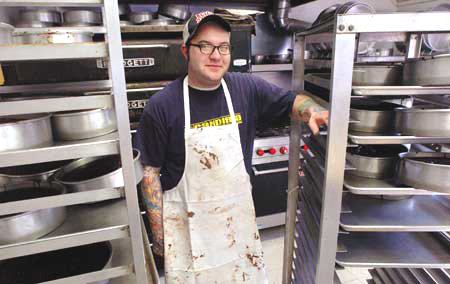By Colleen Lent
Hampton Union, Tuesday, April 13, 2004
[The following article is courtesy of the Hampton Union and Seacoast Online.]

It seems that the low-carb bandwagon is gaining new passengers each week, as products made with flour and sugar are being left in the dust. According to Productscan Online, a market research firm, 816 new products touting a low- or no-carb claim have been introduced to consumers since 2000.
On the Seacoast, however, not everyone is surrendering to the newest weight-loss trend, which some analysts say will fade with the low-fat craze of the mid-1990s.
David and Kathie White, the son-and-mother owners of The Pastry Garden of Hampton, are staying loyal to their last name by offering tried, true and new confections, using plenty of the white ingredients deemed as diet evildoers by Atkins, Zone, and Sugarbusters program followers.
A couple of weeks before The Pastry Garden's April 16 grand opening, David White gave a sneak preview of some of the bakery's anticipated selections, including multilayered wedding cakes, lemon Bavarian pies, and a Mexican spice mousse.
White grimaces verbally at the mention of the low-carb phenomenon.
"Food is the greatest thing in the world," he says. "It's such an art form. I like making it. I like eating it." He says dieters' taste buds are shortchanged and culinary professionals are challenged when traditional ingredients are replaced with flour and sugar alternatives such as isolated soy protein, sucralose, and saccharin. Working with all-purpose, pastry and cake flours is complicated enough.
"It's very scientific," White says. "It's all combinations. It's very easy to screw anything up." Throwing a 50-pound bag of ground soybeans into the mix is asking for trouble.
Market analysts agree the challenges of making a palatable low-carb confection isn't easy, which may explain why Atkins brownie and muffin mixes are more than $5 per package, and candy bars are about $2 apiece.
White says the old adage of planning a balanced diet, exercising regularly and eating sweets in moderation is the equation for those seeking a healthy body. Of course, taking it one step at a time isn't going to result in a loss of 20 pounds in two weeks just before one's 10-year high-school reunion.
"It's kind of like a get rich scheme," White says, referring to the low-carb movement.
When it comes to the design of wedding cakes, White says it is prudent to yield to customer requests.
"The No. 1 thing I learned about wedding cakes is people want what they want," he says, referring to his five years experience of working for Sweet Flours, formerly at the same retail site. "This is someone's wedding. You don't want to ruin someone's wedding."
He does caution customers about unrealistic expectations. Much like hair stylists receiving a magazine clipping featuring the designer coif of a runway model, cake designers receive photos of celebrity wedding cakes and are expected to produce the same results for a nominal fee. Often a $900 Martha Stewart creation can be replicated but requires an entire day of labor and special orders for unusual ingredients and motifs.
"I just don't think people realize how much it costs," White says.
White says baking and decorating wedding cakes is the only time he breaks his rule on avoiding artificial coloring.
"It not a health issue," he says of his resistance to use artificial coloring. "I just don't think it's necessary. If you can find it and it's fake, you can find it real. It's also an artistic thing."
White admits the quest for a natural colorant for a white chocolate and lime Neapolitan continues to be long and arduous journey.
White says it is customary for a culinary-arts professional to be dissatisfied with his or her creations. While fillings for cakes are fairly basic, other recipes require seven or eight tries before they are deemed acceptable White says. He cites cookies as particularly difficult, as obtaining a consistent texture and flavor is critical.
Over the past few months White has been focusing on perfecting recipes and finalizing his spring and summer product line in anticipation of the bakery's opening in mid-April. Future goals include cultivating new wholesale accounts and hiring capable bakers and decorators who are willing to learn the craft without expecting the monetary compensation offered by a Fortune 500 company.
White expects 40 percent of the sales to be obtained through business-to-business accounts and 15 to 20 percent via traditional retail walk-in customers. Wedding cakes will make up the remaining 40 to 45 percent. Currently about 70 businesses, including hotels, delis and restaurants in New Hampshire, Massachusetts and Maine have been targeted as prospects.
The second goal of finding qualified employees more interested in learning than getting rich is the more formidable feat, according to White.
"Unfortunately, that's not any easy thing to find," he says. Yet, White adds that he started as the dishwasher at Sweet Flours as a teen. Now, at 22, he is managing his own business with the help of his mother as his dad and other family members stand on the sidelines as coaches and fans.
"Over the years I moved up in the world." White says. "To me it's not just a bakery. It's very personal."
